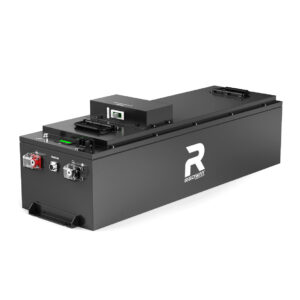What Makes AGM Car Batteries Superior for Modern Vehicles?
AGM (Absorbent Glass Mat) car batteries are advanced lead-acid batteries that use fiberglass mats to hold electrolyte, offering spill-proof design, faster charging, and vibration resistance. They excel in start-stop vehicles and high-demand electrical systems. Their sealed construction reduces maintenance and enhances durability, making them ideal for modern automotive applications where reliability and performance are critical.
What Happens if a LiFePO4 Battery Gets Wet?
How Does an AGM Car Battery Work?
AGM batteries use absorbent glass mats between lead plates to trap electrolytes, enabling efficient oxygen recombination. This prevents water loss and allows maintenance-free operation. The tightly packed design minimizes internal resistance, delivering high bursts of power for engine starts and stabilizing voltage for advanced electronics. The sealed construction prevents leaks, even in extreme orientations.

What Are the Advantages of AGM Over Flooded Batteries?
AGM batteries outperform flooded batteries in key areas: 3x longer cycle life, 40% faster recharge rates, and 50% lower self-discharge. They handle deep discharges better (withstanding 80% depth vs. 50% in flooded) and operate in temperatures from -30°C to 60°C. Their vibration resistance makes them 68% more reliable in rough terrain applications.
The structural advantages become particularly evident in demanding conditions. AGM batteries maintain consistent performance during frequent deep cycles, making them ideal for vehicles with energy recovery systems. Their recombinant gas technology allows 99% efficiency in oxygen recombination versus 95% in gel batteries. This translates to fewer electrolyte losses and better performance in sealed environments like modern engine compartments.
| Feature | AGM | Flooded |
|---|---|---|
| Cycle Life | 500-800 cycles | 200-300 cycles |
| Recharge Time | 4-6 hours | 8-10 hours |
| Vibration Resistance | 68% higher | Standard |
Which Vehicles Require AGM Batteries?
AGM batteries are mandatory for vehicles with: Start-stop systems (saving 5-8% fuel), regenerative braking, or 150+ amp electrical loads. Common applications include luxury cars (BMW/Mercedes), EVs (as auxiliary batteries), RVs, marinecraft, and off-road vehicles. Always consult your manual – using flooded batteries in AGM-specific systems can cause 30% faster component failure.
Modern hybrid vehicles particularly benefit from AGM technology. The 48V mild-hybrid systems found in 2023 models from Ford and Volvo require AGM batteries to handle rapid charge/discharge cycles from regenerative braking. Marine applications demand AGM’s spill-proof design – a single flooded battery spill can release 4.7 liters of sulfuric acid into bilge systems. Recent RV models now specify AGM batteries due to their ability to power inverters while maintaining starter functionality.
Why Do AGM Batteries Last Longer?
The glass mat design reduces plate corrosion (main cause of battery failure by 73%) and prevents acid stratification. AGM batteries maintain 95% charge efficiency vs. 80% in flooded types. Their sealed design eliminates water loss, while the pressure-regulated valves minimize grid oxidation. Properly maintained, AGMs last 6-8 years vs. 3-5 for flooded batteries.
How to Properly Charge an AGM Battery?
Use a smart charger with AGM-specific profile (14.4-14.8V absorption, 13.2-13.8V float). Never exceed 15V – overcharging causes 58% of premature failures. Charge at 20-25% of battery capacity (e.g., 20A for 100Ah battery). Keep temperatures below 40°C during charging. For storage, maintain 12.6V minimum – a 50% discharged AGM loses 3% capacity monthly.
Advanced charging techniques can optimize performance. Three-stage charging is critical: bulk (14.4-14.8V), absorption (maintain voltage until current drops), and float (13.2-13.8V). For jump-starting, limit voltage spikes to 15V maximum. Many 2023 battery maintainers now feature AGM recovery modes that can rehabilitate sulfated batteries through controlled pulse charging.
What Are the Environmental Benefits of AGM Batteries?
AGM batteries are 99% recyclable with lead recovery rates exceeding 97%. Their sealed design prevents 4.2kg of acid spills per battery lifetime. The efficient charging reduces energy waste by 18% compared to flooded types. Some models use 40% recycled lead, lowering manufacturing CO2 by 33% per kWh capacity.
How Does Temperature Affect AGM Performance?
AGM batteries maintain 85% capacity at -18°C vs. 60% in flooded types. High heat (above 35°C) accelerates aging by 50% per 8°C rise. Use thermal wraps in engine compartments. Cold cranking amps (CCA) stay stable within ±2% from -1°C to 27°C. For every 1°C below freezing, charge voltage must increase 0.003V/cell.
“The shift to AGM reflects automotive electrification – a modern vehicle’s electrical demand (2-3kW) requires batteries that can handle 350+ amp loads daily. AGM’s 0.1% annual water loss vs. 15% in flooded batteries makes them essential for start-stop systems cycling 50,000+ times. Future developments include carbon-enhanced AGMs with 20% faster recharge and 30% longer cycle life.”
– Dr. Elena Voss, Automotive Power Systems Engineer
Conclusion
AGM car batteries represent the pinnacle of lead-acid technology, offering unmatched reliability for modern vehicles. Their superior cycle life, maintenance-free operation, and environmental benefits justify the 30-50% cost premium over flooded batteries. As vehicles become more electrified, understanding AGM technology becomes crucial for optimal performance and longevity.
FAQs
- Can I replace a flooded battery with AGM?
- Yes, but requires voltage calibration – most modern alternators automatically adjust. Confirm your charging system supports AGM’s higher voltage requirements (14.4-14.8V).
- How often should I test my AGM battery?
- Perform load tests every 6 months and check voltage monthly. Use conductance testers for accurate state-of-health readings without discharging.
- Are AGM batteries safe in crashes?
- Yes – they meet FMVSS 538 crash standards. The glass mats contain acid even if casing cracks, reducing spill risks by 92% compared to flooded batteries.
